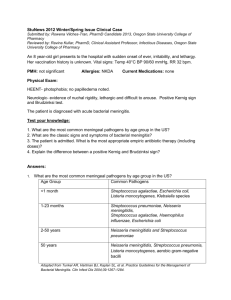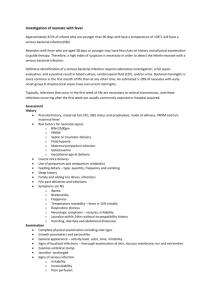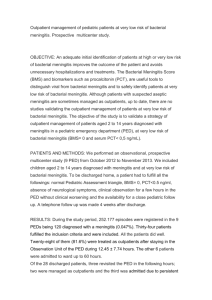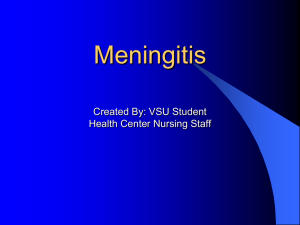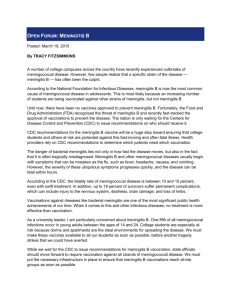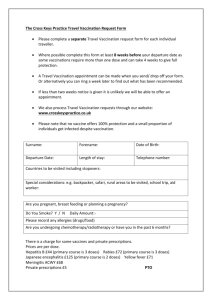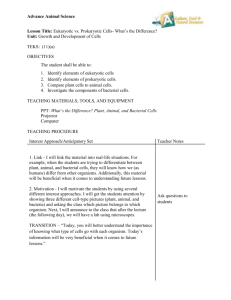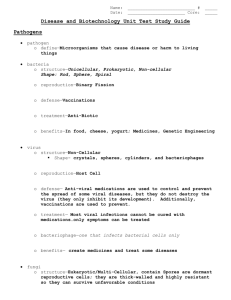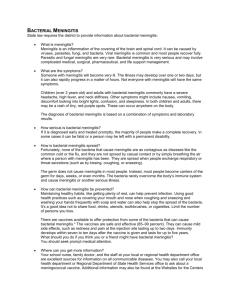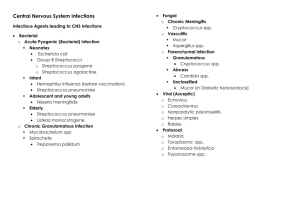Serious Pediatric Infections
advertisement
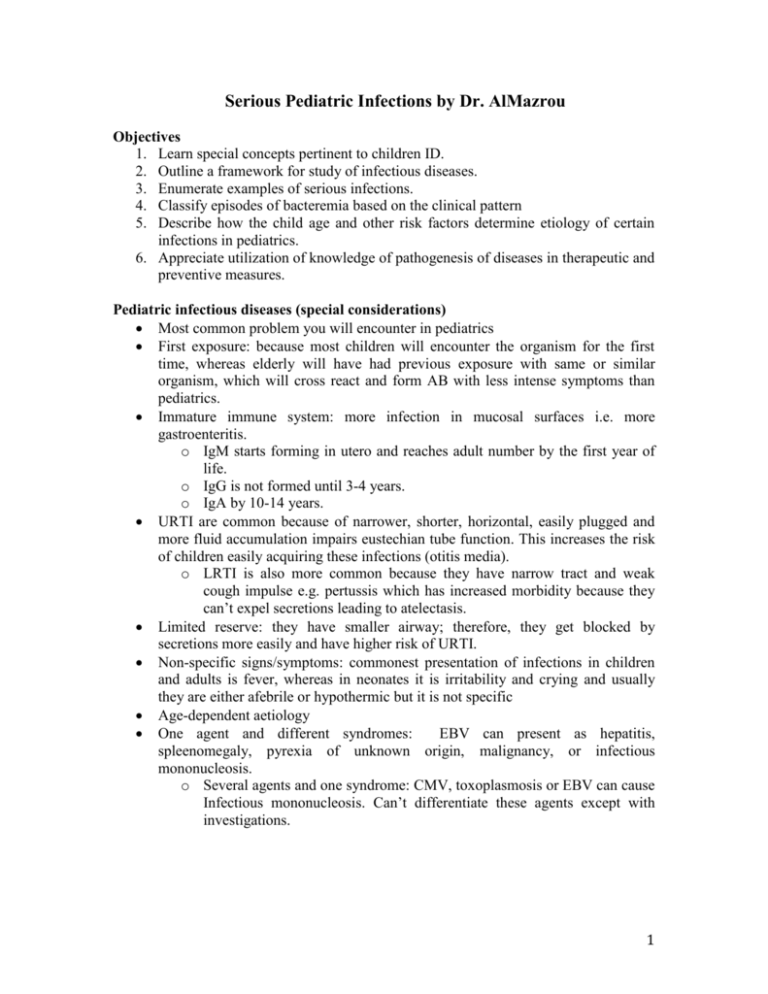
Serious Pediatric Infections by Dr. AlMazrou Objectives 1. Learn special concepts pertinent to children ID. 2. Outline a framework for study of infectious diseases. 3. Enumerate examples of serious infections. 4. Classify episodes of bacteremia based on the clinical pattern 5. Describe how the child age and other risk factors determine etiology of certain infections in pediatrics. 6. Appreciate utilization of knowledge of pathogenesis of diseases in therapeutic and preventive measures. Pediatric infectious diseases (special considerations) Most common problem you will encounter in pediatrics First exposure: because most children will encounter the organism for the first time, whereas elderly will have had previous exposure with same or similar organism, which will cross react and form AB with less intense symptoms than pediatrics. Immature immune system: more infection in mucosal surfaces i.e. more gastroenteritis. o IgM starts forming in utero and reaches adult number by the first year of life. o IgG is not formed until 3-4 years. o IgA by 10-14 years. URTI are common because of narrower, shorter, horizontal, easily plugged and more fluid accumulation impairs eustechian tube function. This increases the risk of children easily acquiring these infections (otitis media). o LRTI is also more common because they have narrow tract and weak cough impulse e.g. pertussis which has increased morbidity because they can’t expel secretions leading to atelectasis. Limited reserve: they have smaller airway; therefore, they get blocked by secretions more easily and have higher risk of URTI. Non-specific signs/symptoms: commonest presentation of infections in children and adults is fever, whereas in neonates it is irritability and crying and usually they are either afebrile or hypothermic but it is not specific Age-dependent aetiology One agent and different syndromes: EBV can present as hepatitis, spleenomegaly, pyrexia of unknown origin, malignancy, or infectious mononucleosis. o Several agents and one syndrome: CMV, toxoplasmosis or EBV can cause Infectious mononucleosis. Can’t differentiate these agents except with investigations. 1 Guidelines for study of infectious diseases Etiology Pathogenesis Clinical manifestations/course: o Immunocompetent o Immunocompromized: seen in patients taking steroids, congenital immunodeficiency e.g. hypogammaglobinemia, chronic diseases (diabetes and renal failure), malnourished or patients with HIV. Epidemiology Mode of transmission: is the most important aspect. Incubation period: is the period from acquiring the disease to the appearance of the first symptom. Reservoir: where it is present in nature (availability in the environment). It is important for prevention. In malaria, the mosquito is the vector and humans are the reservoir. Camels and sheep are the reservoirs in brucellosis, and humans in salmonella typhoid. Period of communicability: the period that you can transmit the organism to other people and must put them either in isolation or keep them away from school. Susceptible individuals Guidelines for study of infectious diseases Diagnosis Complications: are classified as early and late (which can happen after recovery from the disease). Must know the source in order to prevent and counsel. Management o Treatment o Prevention o Infection control Serious pediatric infections 1. Meningitis and encephalitis 2. Neonatal sepsis 3. Epiglotitis 4. Bactermias 5. Osteomyelitis 6. Septic arthritis 7. Endocarditis 8. Tuberculosis, etc. Bacteremia Bacteria in the blood, but doesn’t indicate the severity of the disease. It can be: 1. Transient: the general population can suffer from it, but will be cleared by the reticuloendothelial system; however, can lead to complications in immunocompromised patients. Therefore, give prophylactic antibiotics before 2 dental procedures and patients with synthetic valves, because they are prone to get endocarditis. 2. Occult: Not expected to be bactremic on presentation (some will only have minor symptoms, some will be febrile and septic), but has a positive blood culture. 3. Serious a. Fulminant with shock: common with E-coli and pseudomonas. b. With focal infection. c. Associated with IVD. Meningitis Etiology Pathogenesis Molecular pathophysiology Clinical Manifestations Diagnosis Therapy Complications Prevention o Chemoprophylaxis o Vaccination Bacterial meningitis Etiology Determined by age (according to commonality) 1. Neonates: Group B strep > E-coli (and other gram negatives)> listeria. 2. 3 months – 5 years: strep. pneumoniae > N. meningitides > HiB. 3. >5 years: No HiB even in non-vaccinated children because of vaccination. Special risk factors 1. Post-traumatic: Basal skull fractures: 80% are strep. pneumoniae. 2. Post neurosurgical: staph and gram negatives. 3. Ventricular shunts: staph epidermidis (coagulase negative). 4. Immunocompromised: depends on the organism. 5. Asplenia and SCD: Salmonella and encapsulated organisms. Note: 10 months old and meningitis presentation: LP will show E-coli, so must find the cause because it’s not a common organism in this age group; sinus tract from skin to subarachnoid space from the diaper area because it’s the commonest bacterial organism in diaper infections. 3 Pathogenesis Mucosal colonization > local invasion > bacteremia > Meningeal invasion > bacterial replication > subarachnoid space inflammation. Colonization occurs in nasopharynx, hence the nasopharyngeal aspirate. Replication leads to autolysis, which leads to the release of cell wall component (endotoxin in gram –ve and teichoic acid in gram +ve) >resulting in the release of inflammatory mediators > activating leukocytes causing cytotoxic edema >increase ICP >endothelial injury and thrombosis causing further increase in ICP> resulting in decreased cerebral blood flow. 4 5 Clinical presentation Neonates Older children Diagnosis 1. CBC: leucocytosis or leucopenia (worst prognosis signifies meningococcal disease). Never discharge a patient with normal CBC and fitting clinical picture. 2. Blood culture 60-70% specific. 3. CSF: there are three components in the CSF we should look at- WBC, glucose, and protein For bacterial meningitis, the WBC is mainly polymorphic and the glucose is less that 50% of serum glucose (normal is 2/3 of serum glucose). If it was partially treated bacterial meningitis the lymphocyte predominates. For Viral or TB, the WBC is mainly lymphocytic. Sugar is normal. For fungal and TB meningitis, the glucose is less than 50% the serum glucose. The protein is raised in all, but might be normal in viral. a. Color b. Cell count and differential. c. Chemistry: Sugar & Proteins d. Gram stain is positive in 70-80% of the patients. e. Latex agglutination or co-agglutination is used to detect the antigen instead of culture because the culture takes 24 hours. f. Culture is the gold standard 6 Management: 1. Supportive care is the most important. Careful monitoring of the patient, by checking the blood pressure for hypertension and the respiration for the RR, and pH. 2. Antibiotics 3. Dexamethasone modulates the release of inflammatory mediated factors. Note: Studies were done giving antibodies alone, which showed worse outcome by increasing the inflammatory markers (TNF is higher with AB due to autolysis). On the other hand, dexamethasone with AB gave promising results with values approaching the normal. There is still a need for more data to indicate the need for dexamethasone in every case. Dexamethasone should be given at the time of AB and not after and in some cases it can be given just before (don’t give dexamethasone if it’s late presentation). Long-term dexamethasone decreases deafness, which is a complication of meningitis. Steroids are important because they decrease the level of inflammatory mediators, which are the cause of complications. Complications 1. Early: subdural effusion with fever resolves alone when the patient is on antibiotics. It rarely needs drainage. 2. Late: brain abscess is a rare complication of meningitis and is seen in a specific age group and bacterial organism. 7 Primary Prevention (prevents the local invasion) 1. Chemoprophylaxis Rationale: If one person is infected with meningococcal meningitis, it increases the risk by an 800 to 1000 fold of the community being affected; therefore, we treat the entire family. Protocol 2. Vaccination: HiB, meningococcal, and some require pneumococcal vaccine. Pathogenesis of the prevention Mucosal colonization >(Chemoprophylaxis effect is here)> Local invasion >(vaccination)> Bacteremia >(antibiotic therapy)> Meningeal invasion > bacterial replication > subarachnoid space inflammation. Encephalitis General: Most common pathogen in pediatrics is entero-viruses fortunately they are self-limiting, and the most serious is HSV, which increases morbidity and mortality. Diagnosis: Previously by brain biopsy but nowadays PCR is the diagnostic tool. MRI shows the effects early. Treatment: If HSV encephalitis is suspected, start acyclovir immediately even if the diagnosis was not yet confirmed because this type is very serious. Osteoarticular infections Presentation: the commonest presentation. 1. Pain. 2. Limping. 3. Swelling. Note: Septic arthritis of the hip is very dangerous because it is a deep-seated infection and doesn’t cause any swelling. It can lead to vascular necrosis because the blood supply is from the acetabulum and goes around the joint, if there is pus it will press on the vessels therefore ER drainage is important. 4. In neonates, it is not obvious because they can’t complain but it is noticed when the mother changes the diaper and the baby cries. The neonates usually maintain 8 their hip in lateral rotation and flexion to have more space in the joint and thus relieving the pressure. Imaging Bone change (such as avascular necrosis or periosteal reaction) is not seen on Xray until the 10th day, but it can be detect it earlier by nuclear scan. The radionuclear scan will show increased uptake sequestrum by the osteoclasts and periosteal reaction, which indicates chronic infection. If there is any radiolucency, suspect malignancy. Complications 1. Avascular necrosis. 2. Joint destruction. Treatment 1. Debridement and removal of sequestrum to prevent recurrence along with 2. Long-term antibiotics. Antibiotics use in acute osteomyelitis is 4-6 weeks, and 46 months in chronic. Case: 10 year old limping for two months Orbital Cellulitis Affects the optic nerve and it is an emergency. Perioribital Cellulitis Is usually an extension from the sinuses. 9 Congenital infections (TORCHS) TORCHS and others no longer limited to TORCHS. Certain presentation common to all 1. Hydrocephlus 2. Cerebral Calcifications (seen in toxoplasmosis and CMV) 3. Blue muffin syndrome seen in all 4. Owl eye in urine in CMV Tetanus in neonates Prevented by vaccination of the mother. Two doses if mother is not vaccinated or the doses can’t be determined. The vaccine is safe during pregnancy but better given before. 10
